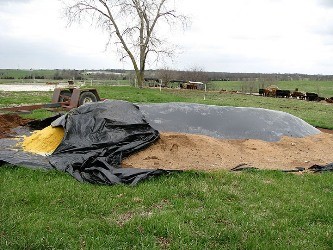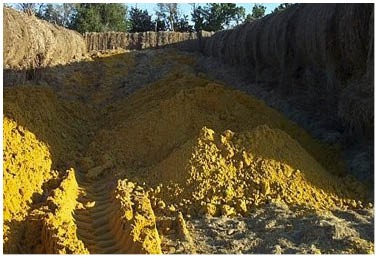The Dairy One Forage Lab excels in providing high quality analyses
and customer service. Our goal is to provide analytical services designed to meet the expanding demands of modern agriculture.
New technology and traditional methods are combined to deliver fast, accurate results.
|
|
| |
By Paul Sirois, MS, PAS - Lab Manager
Byproducts play a large role in today's dairy rations. Typically available at low cost, there is the temptation to include large amounts in the ration and this is where producers can quickly get into trouble. Before considering incorporation of a new byproduct in a ration, ask yourself these five simple questions.
1.
What am I buying? Byproducts can be classified into three categories based on the primary nutrient that they provide:
- Protein - ex. distillers grains, brewers grains,
gluten feed
- Fiber - ex. soy hulls, beet pulp, cottonseed hulls
- Energy - ex. hominy, bakery byproducts,
cereal byproducts
Energy byproducts require special consideration depending upon the source of the energy. Sugar, starch and fat all behave differently in the rumen. Consider the following three energy byproducts: pasta, 67.9% starch; Twinkies, 54.2% sugar; and potato chips, 37.8% fat. All three are viable energy sources, but will be metabolized differently in the rumen. Sugar and starch are rapidly broken down and over-feeding can cause acidosis, followed by reduced DM intake, reduced milk production and/or foot problems. High fat levels can suppress fiber digestion leading to reduced intakes, milk production and fat test. When incorporated incorrectly or over-fed, energy products are apt to cause the most problems. Care must be taken to understand the nature of the byproducts being offered and how to incorporate them into the ration to avoid causing problems.
2.
How consistent is the product?
Not all byproducts are created equal. Supplier and processing will have a large impact on nutrient composition. Table 1. summarizes corn gluten feed samples analyzed by our lab. The "Normal Range" is the average +/- 1 standard deviation and we would expect 68% of all samples to fall within this range. Note that the spread on gluten feed is 14.9 and 28 percentage points for CP and SP, respectively! Table 2. summarizes bakery byproducts and the "big three" of fat, starch, and sugar. Bakery byproducts are a wide open category that includes bread, bagels, pizza crusts, cookies, donuts, Twinkies, etc.. As such, nutrient composition can vary wildly. Don't rely on industry averages for ration formulation. Contact the supplier for typical nutrient values on their product. Furthermore, it's always a good practice to analyze the feed to be confident in its nutrient composition.
Table 1. Corn Gluten Feed Statistics
|
|
Number
|
Average
|
Normal Range
|
|
CP%
|
1,475
|
24.0
|
16.6 - 31.5
|
|
Sol. Prot.%CP
|
750
|
51
|
37 - 65
|
|
ADF%
|
1,225
|
11.5
|
8.5 - 14.5
|
|
NDF%
|
1,239
|
35.9
|
29.7 - 42.1
|
|
NEL, Mcal/lb
|
1,231
|
0.77
|
0.74 - 0.81
|
|
P%
|
|
1.05
|
0.82 - 1.29
|
Table 2. Bakery Byproduct Statistics
|
Number
|
Average
|
Normal Range
|
|
CP%
|
2,058
|
13.2
|
10.7 - 15.8
|
|
ADF%
|
927
|
7.2
|
1.9 - 12.5
|
|
NDF%
|
1,113
|
12.8
|
4.9 - 20.7
|
|
NEL, Mcal/lb
|
1.106
|
0.99
|
0.93 - 1.07
|
|
P%
|
861
|
0.38
|
0.19 - 0.58
|
|
Fat%
|
1,875
|
9.7
|
6.3 - 13.2
|
|
Starch%
|
622
|
37.7
|
24.2 - 51.2
|
|
WSC% (sugar)
|
455
|
20.1
|
11.5 - 28.7
|
3.
How consistent/available is the supply?
Daily, weekly, monthly, seasonally? Cows like consistency and perform best when the diet is the same from day to day. If you are going to invest in a byproduct, think of feeding it in terms of weeks or months.
4.
How will it be stored and handled? Is the product wet or dry? Is there adequate bin space, flat storage or a pad to minimize waste and maximize ease of handling? Will run-off from wet products be an issue? If available seasonally, what are my long term storage options? Figures 1. & 2. illustrate two approaches for storing wet distillers grains with varying degrees of success. In Figure 1., wet distillers grains are covered in plastic to ferment and ensile the grains providing good long term storage. In Figure 2., the grains are dumped between rows of big round bales forming an impromptu bunk silo. From the picture, no one would be surprised if the amount of grain wasted was greater than 40%!
Figure 1. Wet distillers grains - good storage option

Figure 2. Wet distillers grains - less than ideal storage

5.
How much can be fed to a) contribute to daily DM intake and b) stay ahead of spoilage?
Particularly with wet products, the method of storage and environmental conditions will play a large role. This is especially true in the warmer months when wet products are more susceptible to spoilage. In general, any wet product that is fed fresh, should be fed out within 5 days (2-3 days in hot weather). Fermented products, like any silage, should be fed at a rate to minimize spoilage on the face. While we certainly want to minimize spoilage, more important is the rate of inclusion. Work with a nutritionist to gradually introduce the feed into the diet and set a maximum to avoid problems.
If you come across a new byproduct and are unsure of its nutrient content, visit the feed library on our website
http://dairyone.com/analytical-services/feed-and-forage/feed-composition-library/. This will give you an idea if it's worth consideration for incorporation into your ration. Of course, an actual analysis will increase your level of confidence regarding nutrient composition and how it can be best fed.
Answering the questions above ahead of time will allow you to successfully utilize byproducts in the diet and reduce feeding cost.
|
|
"WANTED"
Sales and Technician Support Specialist
for the Dairy One Forage and Soils Lab. Click here for more information.
|
|
| |

Dairy One - Forage Laboratory
730 Warren Road ~ Ithaca, NY ~ 14850
Phone: 1-800-344-2697 Ext. 9962
|
|
|
|